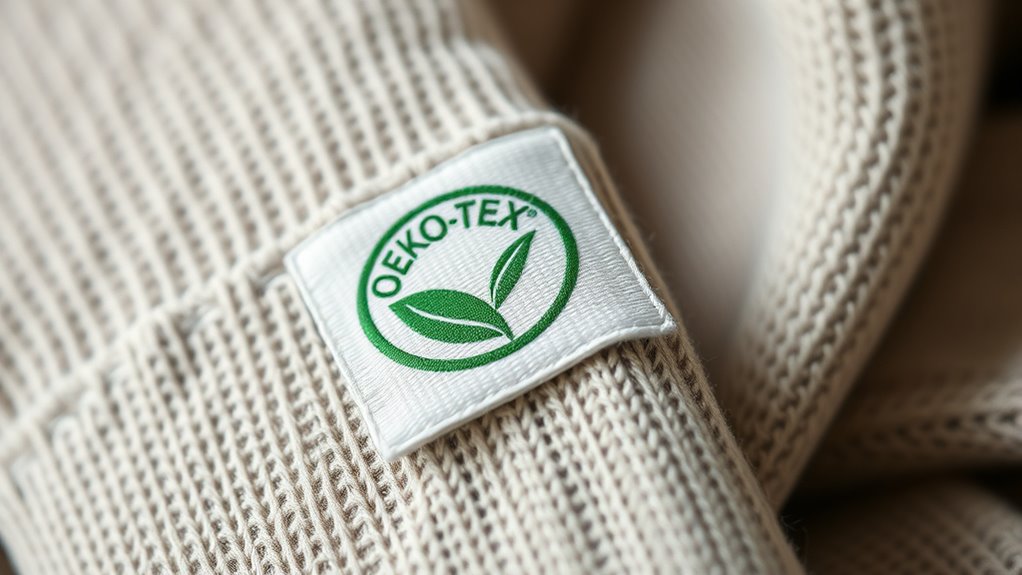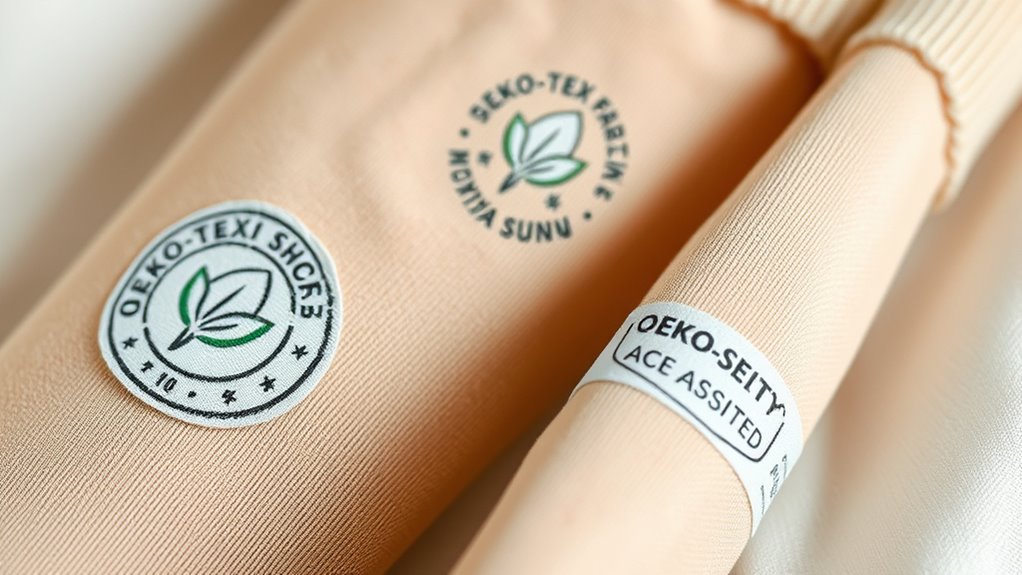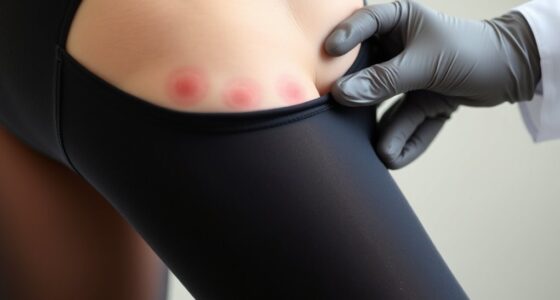OEKO‑TEX certification on hosiery means the product has been tested for harmful chemicals and meets safety standards recognized worldwide. It indicates that the product has undergone lab testing for toxins like dyes, pesticides, and heavy metals, but it doesn’t guarantee complete safety or complete environmental responsibility. Keep in mind that certification has limitations and doesn’t cover all potential risks—continue to explore to understand what OEKO‑TEX really signifies.
Key Takeaways
- OEKO‑TEX certification indicates hosiery has been tested for harmful substances and meets safety and environmental standards.
- It primarily confirms product safety but does not guarantee complete absence of all toxins or environmental impact.
- Different OEKO‑TEX standards (e.g., Standard 100, STeP) focus on chemical safety, responsible manufacturing, and sustainability.
- Certification involves rigorous lab testing, yet results can vary between batches and laboratories.
- OEKO‑TEX supports safer, eco-friendly products but does not cover all aspects of sustainability or social responsibility.
Understanding OEKO‑TEX Certification: An Overview

OEKO‑TEX certification is a widely recognized standard that assures hosiery products meet strict safety and environmental criteria. When you see this label, it means the products have been tested for dye stability, ensuring that colors won’t easily fade or bleed during use or washing. This certification also emphasizes the use of eco friendly materials, reducing harmful impacts on the environment. You can feel confident that hosiery with an OEKO‑TEX label is produced responsibly, using sustainable resources and safe dyes. This standard helps you make informed choices, knowing your hosiery not only looks good but also aligns with eco-conscious values. Ultimately, OEKO‑TEX certification guarantees a safer, more sustainable product for you and the planet. HEPA filtration is one of the key technologies that ensure the safety and quality of air purification.
The Testing Process Behind OEKO‑TEX Labels

When you see an OEKO‑TEX label, it means the product has undergone rigorous laboratory testing. These tests assess safety and toxin levels to make certain your hosiery is free from harmful substances. Understanding this process helps you trust the standards behind your favorite pairs. Additionally, OEKO‑TEX standards include testing for harmful chemicals, ensuring the product is safe for prolonged skin contact.
Laboratory Testing Procedures
Laboratory testing is a crucial step in verifying that hosiery products meet strict safety and environmental standards. During testing, experts examine dye penetration to ensure colors are securely fixed and won’t bleed or stain. They also analyze packaging materials to confirm they don’t contain harmful substances and are safe for consumers and the environment. The process involves collecting samples from production batches and subjecting them to various tests, including chemical analysis and physical assessments. These procedures help identify any potential toxins or unsafe components. By thoroughly evaluating both the hosiery and packaging, laboratories guarantee products comply with OEKO‑TEX standards, giving you confidence that the items you purchase are safe, eco-friendly, and responsibly manufactured. Additionally, understanding testing procedures helps consumers make informed decisions about product safety and environmental impact.
Safety and Toxin Standards
To guarantee hosiery products are safe for consumers and the environment, rigorous testing is conducted to detect harmful toxins and chemicals. The testing process ensures dye safety by checking for residual dyes and colorants that could pose health risks. It also verifies manufacturing practices, confirming that production methods follow strict safety standards. OEKO‑TEX tests for a wide range of substances, including pesticides, heavy metals, and formaldehyde, ensuring the hosiery is free from dangerous chemicals. This thorough evaluation helps you trust that products bearing the label meet high safety criteria. Additionally, the testing process examines the environmental impact of production methods to promote sustainable practices. By maintaining strict safety and toxin standards, OEKO‑TEX promotes healthier hosiery options while encouraging responsible manufacturing practices across the industry.
Different OEKO‑TEX Standards and Their Significance

Different OEKO‑TEX standards play a crucial role in certifying the safety and sustainability of hosiery products, helping you identify textiles free from harmful substances. Each standard targets specific aspects of textile production, emphasizing sustainable manufacturing and effective chemical management. The OEKO‑TEX Standard 100 focuses on testing textiles for harmful chemicals, ensuring products are safe for consumers. The OEKO‑TEX Standard 1000 emphasizes environmentally friendly and socially responsible manufacturing processes. Meanwhile, the OEKO‑TEX STeP standard promotes sustainable production practices, including waste management and resource efficiency. By understanding these standards, you can make informed choices that align with your values, supporting brands committed to reducing environmental impact and maintaining high safety standards. These standards collectively reinforce the importance of responsible manufacturing in the textile industry.
What Harmful Substances Are Tested For?

Hosiery certified under OEKO‑TEX standards are rigorously tested for a range of harmful substances that could pose health risks to consumers. These tests include checking for chemical residues that might linger from manufacturing processes and pose long-term health concerns. You can trust that allergen testing is also part of the process, ensuring your skin isn’t exposed to common irritants. Moreover, OEKO‑TEX certification involves comprehensive testing protocols that identify potential chemical hazards before products reach consumers.
- Detecting toxic chemicals that can cause skin irritation or more severe health issues
- Screening for allergenic substances that trigger sensitive reactions
- Ensuring no harmful dyes or finishes remain on the hosiery
- Confirming chemical residues are within safe limits for everyday wear
These thorough tests give you peace of mind, knowing your hosiery is safe and free from dangerous substances.
Interpreting OEKO‑TEX Labels on Hosiery Products

Interpreting OEKO‑TEX labels on hosiery products helps you easily identify items that meet strict safety standards. These labels often include key details like fabric composition and manufacturing location, which guide your choices. For example, a label may specify the percentage of cotton or synthetic fibers, indicating durability and comfort. The manufacturing location can also hint at quality standards and ethical practices. Here’s a quick guide:
| Label Element | What it Means | Why it Matters |
|---|---|---|
| Fabric Composition | Material blend, fiber percentages | Affects comfort and durability |
| Manufacturing Location | Country of origin | Indicates quality standards and ethics |
| Certification Mark | OEKO‑TEX symbol | Ensures safety and chemical testing |
| Care Instructions | Washing and handling details | Maintains product integrity |
| Batch Number | Production lot info | Traceability for safety |
Understanding fabric composition helps you choose hosiery that aligns with your comfort and safety preferences.
Benefits of Choosing OEKO‑TEX Certified Hosiery

Choosing OEKO‑TEX certified hosiery offers you peace of mind by ensuring the products have undergone rigorous testing for harmful chemicals. This certification guarantees fiber durability, so your hosiery stays in great shape through many wears and washes. You’ll also stay confident that your fashion choices are safe and eco-friendly, aligning with current trends that prioritize sustainability. With OEKO‑TEX, you can enjoy stylish hosiery that doesn’t compromise on quality or safety. It’s a smart way to invest in versatile pieces that fit seamlessly into your wardrobe. Plus, knowing your hosiery adheres to strict standards helps you feel good about supporting responsible manufacturing practices. Additionally, OEKO‑TEX certification is widely recognized in the textile industry, reflecting a commitment to all waterparks safety and environmental responsibility. Ultimately, OEKO‑TEX certified hosiery empowers you to make fashion choices that are both trendy and conscientious.
Limitations and Things to Keep in Mind About OEKO‑TEX

While OEKO‑TEX certification shows your hosiery meets safety standards, it’s important to understand its limitations. The scope of testing doesn’t cover every chemical or toxin, and results can vary between labs. Keep in mind, it’s not a guarantee that your hosiery is completely free of harmful substances. Additionally, testing protocols may not account for newborn safety guidelines related to chemicals or toxins in textiles.
Certification Scope Limits
Although OEKO‑TEX certification indicates that hosiery has been tested for harmful substances, it’s important to understand its scope limitations. The certification primarily focuses on chemical safety within tested fabrics, but it doesn’t cover every aspect of environmental impact or all manufacturing processes. This means some harmful chemicals or environmental concerns might still exist outside the scope of certification. You should be aware that OEKO‑TEX doesn’t guarantee full sustainability or safe production practices across the entire supply chain.
- You could still unknowingly support factories with poor environmental practices.
- Chemical safety isn’t guaranteed for dyes or treatments beyond testing scope.
- Limited scope might miss long-term environmental effects.
- The label doesn’t verify ethical labor or sustainable sourcing.
Independent Testing Variability
Independent testing for OEKO‑TEX certification can vary considerably between laboratories, which means results aren’t always consistent or fully comparable. Manufacturing variability can influence test outcomes, as differences in production batches, fabric compositions, and dyeing processes may lead to inconsistent testing results. Additionally, testing inconsistencies can arise from variations in laboratory procedures, equipment calibration, or interpretation of results. These factors highlight that a single test might not perfectly reflect the overall safety or toxin levels across all production runs. Furthermore, testing variability can impact the reliability of results, emphasizing the importance of considering multiple factors when evaluating certification. As a consumer or manufacturer, it’s important to understand that OEKO‑TEX labels indicate compliance based on specific tests, but they don’t guarantee uniformity across every item or batch. Recognizing these limitations helps set realistic expectations about what OEKO‑TEX certification truly signifies.
Not a Toxin Guarantee
OEKO‑TEX certification is often seen as a mark of safety, but it doesn’t guarantee that a product is completely free of toxins. While it tests for certain harmful substances, it doesn’t eliminate all chemical residues or ensure dye safety. You might still be exposed to residual chemicals from manufacturing or dyes that aren’t fully tested. It’s essential to remember that certification doesn’t mean a product is 100% safe.
Be aware of these limitations:
- Chemical residues may linger despite certification
- Some harmful substances aren’t tested for
- Dyes could still cause allergic reactions
- Safety depends on responsible manufacturing practices
Stay informed and choose brands that prioritize transparency and rigorous testing beyond OEKO‑TEX standards.
Frequently Asked Questions
Can Oeko‑Tex Certification Guarantee Allergy-Free Hosiery?
You might wonder if OEKO‑TEX certification guarantees allergy-free hosiery. While it involves rigorous chemical testing to ensure products are free from harmful substances, it doesn’t specifically make hypoallergenic claims. So, even with OEKO‑TEX certification, your hosiery isn’t guaranteed to be allergy-free. If you have sensitive skin, look for products explicitly labeled hypoallergenic, and consider testing new hosiery on a small skin patch first.
How Often Are Oeko‑Tex Standards Updated or Revised?
They say “fortune favors the prepared,” and the same applies to OEKO‑TEX standards. You should know that standards review and certification updates happen regularly, typically every 1 to 2 years. This guarantees the certification stays current with new scientific data and industry practices. Staying informed about these updates helps you trust that products bearing OEKO‑TEX labels meet consistent, evolving safety and environmental criteria.
Are There Different Certification Levels Within Oeko‑Tex for Hosiery?
You’ll find that OEKO‑TEX offers different certification tiers for hosiery, which helps you distinguish product safety and sustainability levels. These certification tiers include various label distinctions, such as Standard 100, which certifies that textiles are free from harmful substances, and others like Made in Green, indicating eco-friendly production. Knowing these tiers guides you in choosing hosiery that aligns with your safety standards and environmental values.
Does Oeko‑Tex Certification Apply to All Types of Hosiery Materials?
Imagine a vast ocean of hosiery, where OEKO‑TEX certification waves across all material types, ensuring safety and quality. Yes, OEKO‑TEX certification applies to many material types, but its scope isn’t universal. It covers common fabrics like cotton, wool, and synthetic fibers, but some specialty or new materials might not be included. So, you should check each product’s certification scope to know for sure.
How Can Consumers Verify the Authenticity of an Oeko‑Tex Label?
To verify an OEKO‑TEX label, you should start with product verification by checking the label’s authenticity online through the OEKO‑TEX database or website. Be cautious of counterfeit detection by inspecting for inconsistencies like poor printing or missing holograms. Always buy from reputable sources and look for official certification numbers. This way, you guarantee the hosiery’s safety, sustainability, and genuine OEKO‑TEX certification.
Conclusion
When you pick OEKO‑TEX certified hosiery, you’re not just choosing comfort but also trusting that harmful substances are kept at bay. It’s a coincidence that these labels often appear when you need reassurance the most—like during sensitive skin moments or eco-conscious shopping. So, next time you see that label, remember it’s more than just a mark; it’s a quiet promise that your hosiery has been tested for safety, just when you need it most.









